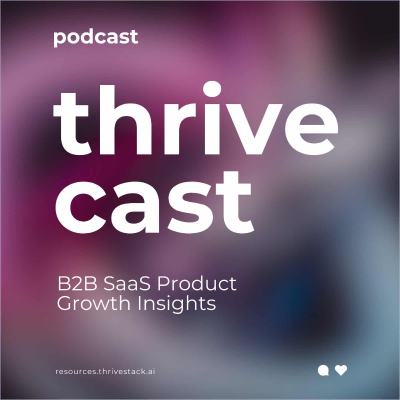
Thrivecast
englanti
Talous & ura
Rajoitettu tarjous
3 kuukautta hintaan 1 €
Sitten 7,99 € / kuukausiPeru milloin tahansa.
- Podimon podcastit
- Lataa offline-käyttöön
Lisää Thrivecast
Unlock the secrets of Product-Led Growth success and thrive with expert insights, strategies, and success stories in every episode! www.hybridgtm.com
Kaikki jaksot
62 jaksotRethinking the Funnel: How B2B Growth is Being Rewritten by AI
John Neeson — the mind behind the legendary B2B Demand Waterfall and Co-Founder of SiriusDecisions — joins Gururaj Pandurangi to trace the evolution of how companies create, measure, and grow demand. From pioneering the alignment between sales and marketing to forecasting how AI will reshape the buyer’s journey, John shares lessons that defined two decades of B2B go-to-market strategy. Key Insights * Origins of SiriusDecisions. John built Sirius to answer a simple CEO question: “I gave you $20M — what did I get back?” The firm transformed marketing from art into measurable science. * The evolution of the Demand Waterfall. What began as a simple lead definition matured into the classic, revenue, and demand-unit waterfalls — each mapping closer to real buying behavior. * From creating demand to activating it. Modern marketing’s challenge isn’t generating leads; it’s recognizing and activating intent across fragmented digital journeys. * Buyers are in control. Two decades ago, buyers met sales to learn. Today, they research independently and expect sellers to be context-ready from the first touch. * Product-led and sales-led models are merging. The best companies balance both — using data to harness existing demand while creating new demand through storytelling. * Alignment equals profitability. SiriusDecisions data showed organizations with tight sales–marketing alignment grew faster and retained more customers. * Analytics is the new OS. As AI transforms digital channels, analytics becomes the engine of visibility, efficiency, and retention. * AI is the next frontier. “We won’t be talking about digital marketing — it’ll all be AI marketing,” John predicts, as discovery shifts from Google search to AI interfaces. Actionable Takeaways * Redefine the funnel. Move from counting MQLs and SQLs to tracking buying groups and demand units that reflect collective intent. * Measure activation over volume. Lead quality and conversion velocity matter more than lead count. * Break functional silos. True growth comes when sales, marketing, and product teams share data, signals, and accountability. * Shift focus to retention. Expansion and renewal metrics are now the strongest indicators of sustainable growth. * Adopt AI early. Use it to identify intent, predict churn, and personalize engagement, while preserving human context and storytelling. * Build analytics fluency. Treat analytics not as reporting, but as a real-time strategic layer. * Prepare for AI-driven discovery. Tomorrow’s buyer journeys begin in AI chats — not search engines or inboxes. Resources Mentioned * SiriusDecisions Demand Waterfall – The original B2B alignment framework. * Winning by Design (Bow Tie Model) – Modern full-funnel framework linking acquisition and retention. * Crossing the Chasm / CASA Model – Framework for category creation and market adoption. * Gartner Hype Cycle – For assessing AI maturity and timing go-to-market bets. For B2B Founders & GTM Leaders Funnels are no longer linear, and demand is no longer created — it’s discovered, activated, and expanded through intelligence. In the AI era, alignment and analytics are the new competitive advantages. 🎧 Loved the episode?Subscribe to ThriveCast for more behind-the-scenes stories from the builders shaping the future of SaaS. This is a public episode. If you would like to discuss this with other subscribers or get access to bonus episodes, visit www.hybridgtm.com [https://www.hybridgtm.com?utm_medium=podcast&utm_campaign=CTA_1]
The Growth Operating System — Building Alignment, Activation, and Accountability
Andrew Capland — one of the most respected voices in product-led growth — returns to ThriveCast to unpack what he calls the “Growth Operating System.” After years leading activation, retention, and experimentation programs at leading SaaS companies like HubSpot and Wistia, Andrew realized growth isn’t about more tactics — it’s about how teams execute, align, and communicate across silos.In this episode, he explains how today’s growth leaders can build a repeatable operating system that turns strategy into consistent execution — even in the age of AI. Key Insights * Ideas are cheap. Execution wins.Every company has access to playbooks and frameworks — the real challenge is alignment, communication, and follow-through. * Growth leadership is a new ladder.Moving from individual contributor to growth lead means learning new skills — influencing peers, managing pushback, and driving cross-functional clarity. * Effectiveness > rightness.Knowing what to do isn’t enough. The best growth leaders learn to persuade, align, and prioritize under uncertainty. * AI won’t replace context.Tools can generate frameworks, but they can’t replicate judgment, timing, or human communication in the boardroom. * Collaboration must start early.Teams lose time fixing misalignments because they collaborate at the end — not during the first 20 % of scoping. * Product-market fit can vanish fast.AI has accelerated competitive shifts; even mature SaaS companies can lose PMF in months. Actionable Takeaways * Build your own Growth OS.Define rituals, scorecards, and decision frameworks that align marketing, product, and revenue. * Use a RACI Matrix.Clarify who’s Responsible, Accountable, Consulted, and Informed before starting any initiative. * Separate “company” metrics from “capability” metrics.Execs care about revenue; your team should focus on activation and retention as the true growth levers. * Coach for alignment.Prime your updates — tell the “why” before showing the “what.” It builds trust across teams. * Be the problem expert.The person closest to the problem always earns the right to design the solution. Resources Mentioned * Delivering Value.co / OS – The Growth Operating System toolkit and community. * Reforge – Advanced programs on growth strategy and experimentation. * RACI Matrix – Cross-functional collaboration framework. * ThriveStack Scorecards – Measure activation, retention, and correlation to revenue. For Growth Leaders Most growth teams don’t fail because of bad ideas — they fail because alignment and communication break down faster than experiments succeed. Build your system before you build your next campaign. 🎧 Loved the episode?Subscribe to ThriveCast for more behind-the-scenes stories from the builders shaping the future of SaaS. This is a public episode. If you would like to discuss this with other subscribers or get access to bonus episodes, visit www.hybridgtm.com [https://www.hybridgtm.com?utm_medium=podcast&utm_campaign=CTA_1]
Why We Buy: The Hidden Psychology of Conversions
Chris Silvestri — a software-engineer-turned-conversion-copywriter — shares how understanding human psychology, UX, and messaging consistency can transform a SaaS website from a brochure into a persuasive buying experience.He breaks down why “words alone don’t convert,” how today’s buyer journey starts before they reach your website, and what modern founders must know about message-market fit. Key Insights * Words alone don’t convert — clarity and structure do.Copy works only when paired with the right visual hierarchy and UX flow. * Your website is a confirmation engine, not a sales pitch.Buyers already have formed opinions from AI, peers, and reviews before they arrive. * Positioning → Messaging → Copy is the true sequence.Define who you help and how you’re different before writing a single word. * Emotion drives decisions.People move either away from pain or toward desired outcomes — know which one motivates your ICP. * Friction kills conversions.Poor clarity, decision fatigue, and inconsistent CTAs reduce sign-ups more than pricing ever does. Actionable Takeaways * Map your buyer’s conversation before writing your homepage. Match what they already believe and expect. * Design “micro-yeses.” Every section should answer: Is this for me? Do I trust them? What happens next? * Be consistent across channels. Inconsistent messaging confuses not just humans but also AI search and LLMs. * Don’t oversimplify. Be clear, not generic — clarity means using the right words for the right audience. * Find product–market fit before message–market fit. Only then can you meaningfully shape your narrative. Resources Mentioned * Conversion Alchemy – Chris’s consulting practice blending psychology, UX, and copywriting. * Bob Mesta – Co-creator of Jobs-to-Be-Done framework. * Forrester’s “Buying Networks” research – On how peer groups and AI shape B2B decisions. * “The User Illusion” – Book on cognition and cognitive load in communication. * Moz SEO case study – Simplifying positioning from “All-in-One” to “The Simplest SEO Tool.” For Founders & Marketers If your website explains what you do but not why it matters to your buyer’s brain, you’re missing conversions.Great messaging isn’t written — it’s designed for how humans decide. Loved the episode?Subscribe to ThriveCast for more behind-the-scenes stories from the builders shaping the future of SaaS. This is a public episode. If you would like to discuss this with other subscribers or get access to bonus episodes, visit www.hybridgtm.com [https://www.hybridgtm.com?utm_medium=podcast&utm_campaign=CTA_1]
Freemium in the Age of AI: Myth, Model, or Growth Engine?
In this week’s ThriveStack webinar, we sat down with Dave Boyce—author, product-led growth (PLG) advocate, and seasoned operator—to unpack the realities of freemium in SaaS. With AI transforming business models and unit economics, the debate around whether freemium accelerates growth or drains resources has never been more relevant. Dave shared lessons from his own journey from sales-led to PLG, and the hard truths behind monetization, activation, and product-market fit in today’s SaaS landscape. Key Insights * Freemium is just one monetization model. It’s not a silver bullet but part of a broader PLG strategy that includes free trials, reverse trials, and self-service onboarding. * Product-market fit comes before scaling. Freemium won’t save a product that hasn’t achieved early user success and retention. * Activation is everything. The first user impact (“first impact moment”) must happen before you ask for money; otherwise, monetization attempts backfire. * Marketing still matters. PLG doesn’t eliminate marketing—it shifts focus toward growth loops, viral mechanics, and blended acquisition strategies. * Established companies struggle with PLG. Legacy sales-led orgs face cultural and operational resistance, but adjacent plays (e.g., self-service renewals, expansion features) offer practical entry points. Actionable Takeaways * Start with founder-led selling. In early stages, hustle for feedback before chasing signups at scale. * Instrument activation. Define and track the “first impact” moment that signals true product-market fit. * Align monetization with value delivery. Trigger paywalls only after customers experience impact. * Experiment relentlessly. Treat failed freemium experiments as data points—iterate quickly to find what sticks. * Incentivize sales teams correctly. Remove channel conflict by giving quota credit for PLG-driven expansions. * Layer PLG adjacently in mature orgs. Start with renewals or expansions before tackling top-of-funnel freemium. Resources Mentioned * Dave Boyce’s new book on Freemium and PLG (launching August 26, available on Amazon). * PLG MBA Program (referenced as part of Dave’s background). * ThriveStack Customer Analytics – for tracking activation, retention, and growth loops. * Case studies of Dropbox, MongoDB, Clickhouse, Timescale, MotherDuck, and others on freemium and PLG strategies. If you’re a SaaS founder or growth leader navigating the tension between scaling fast and building to last, you’ll want to catch this conversation. 🎧 Loved the episode?Subscribe to ThriveCast for more behind-the-scenes stories from the builders shaping the future of SaaS. This is a public episode. If you would like to discuss this with other subscribers or get access to bonus episodes, visit www.hybridgtm.com [https://www.hybridgtm.com?utm_medium=podcast&utm_campaign=CTA_1]
Future of SaaS, Investments and Innovations: A Fireside Chat with Dave Hersh
ThriveStack and Dave HershAug 20, 2025 In this fireside chat, Gururaj Pandurangi sits down with Dave Hersh, founding CEO of Jive Software and now a coach to startup founders and leaders. From scaling Jive from bootstrapped beginnings to IPO, to guiding today’s SaaS teams through turbulent markets, Dave shares a candid look at what’s broken in venture-backed growth, what founders should focus on instead, and how to align both investors and customers without losing sight of purpose. We explore his founder journey, the tension between investor pressure and customer needs, the waste of premature scaling, and why he believes emotional-market fit—the resonance a product has with its users—matters just as much as product-market fit. Listen now on Apple, Spotify, Castbox, Google, and YouTube. “Growth without profit, without purpose, can become toxic. The real challenge is building something that grows and endures.”— Dave Hersh, Founding CEO of Jive Software Key Insights ⚖️ Investor Pressure vs. Customer NeedsWhy short-term expectations often distort long-term product and strategy decisions—and how founders can rebalance. 💸 The Waste in Venture CapitalGrowth-at-all-costs has left many companies fragile. Dave explains how to recognize premature scaling before it’s too late. ❤️ Emotional-Market FitBeyond functionality, companies win when they create loyalty and resonance with customers at an emotional level. 🚀 Coaching Conscious LeadersAfter Jive, Dave dedicated his time to helping founders navigate growth without burning out themselves—or their companies. Actionable Takeaways * For Founders: Don’t let investor expectations define your roadmap; customer outcomes should. * For Growth Leaders: Emotional resonance is the moat—look beyond metrics to why people truly care. * For Investors: Hypergrowth isn’t a strategy; durability is. * For SaaS Teams: Build models that balance profit with growth from day one. Resources Mentioned * Jive Software IPO journey * Conscious leadership frameworks * ThriveStack Customer Analytics: www.thrivestack.ai [https://www.thrivestack.ai/?utm_source=chatgpt.com] If you’re a SaaS founder or growth leader navigating the tension between scaling fast and building to last, you’ll want to catch this conversation. 🎧 Loved the episode?Subscribe to ThriveCast for more behind-the-scenes stories from the builders shaping the future of SaaS. This is a public episode. If you would like to discuss this with other subscribers or get access to bonus episodes, visit www.hybridgtm.com [https://www.hybridgtm.com?utm_medium=podcast&utm_campaign=CTA_1]
Valitse tilauksesi
Rajoitettu tarjous
Premium
Podimon podcastit
Lataa offline-käyttöön
Peru milloin tahansa
3 kuukautta hintaan 1 €
Sitten 7,99 € / kuukausi
Premium
20 tuntia äänikirjoja
Podimon podcastit
Lataa offline-käyttöön
Peru milloin tahansa
30 vrk ilmainen kokeilu
Sitten 9,99 € / month
Premium
100 tuntia äänikirjoja
Podimon podcastit
Lataa offline-käyttöön
Peru milloin tahansa
30 vrk ilmainen kokeilu
Sitten 19,99 € / month
3 kuukautta hintaan 1 €. Sitten 7,99 € / kuukausi. Peru milloin tahansa.

































